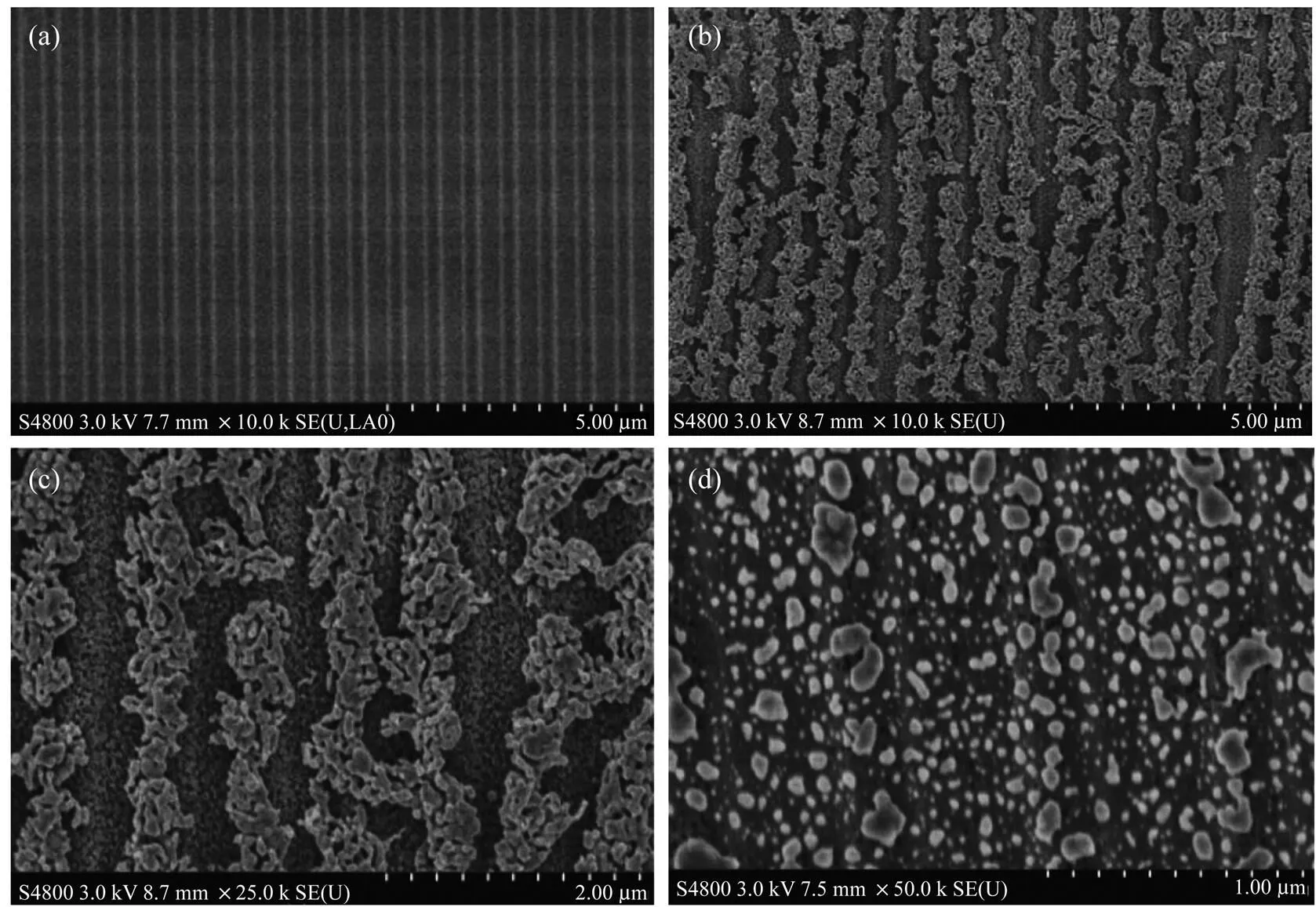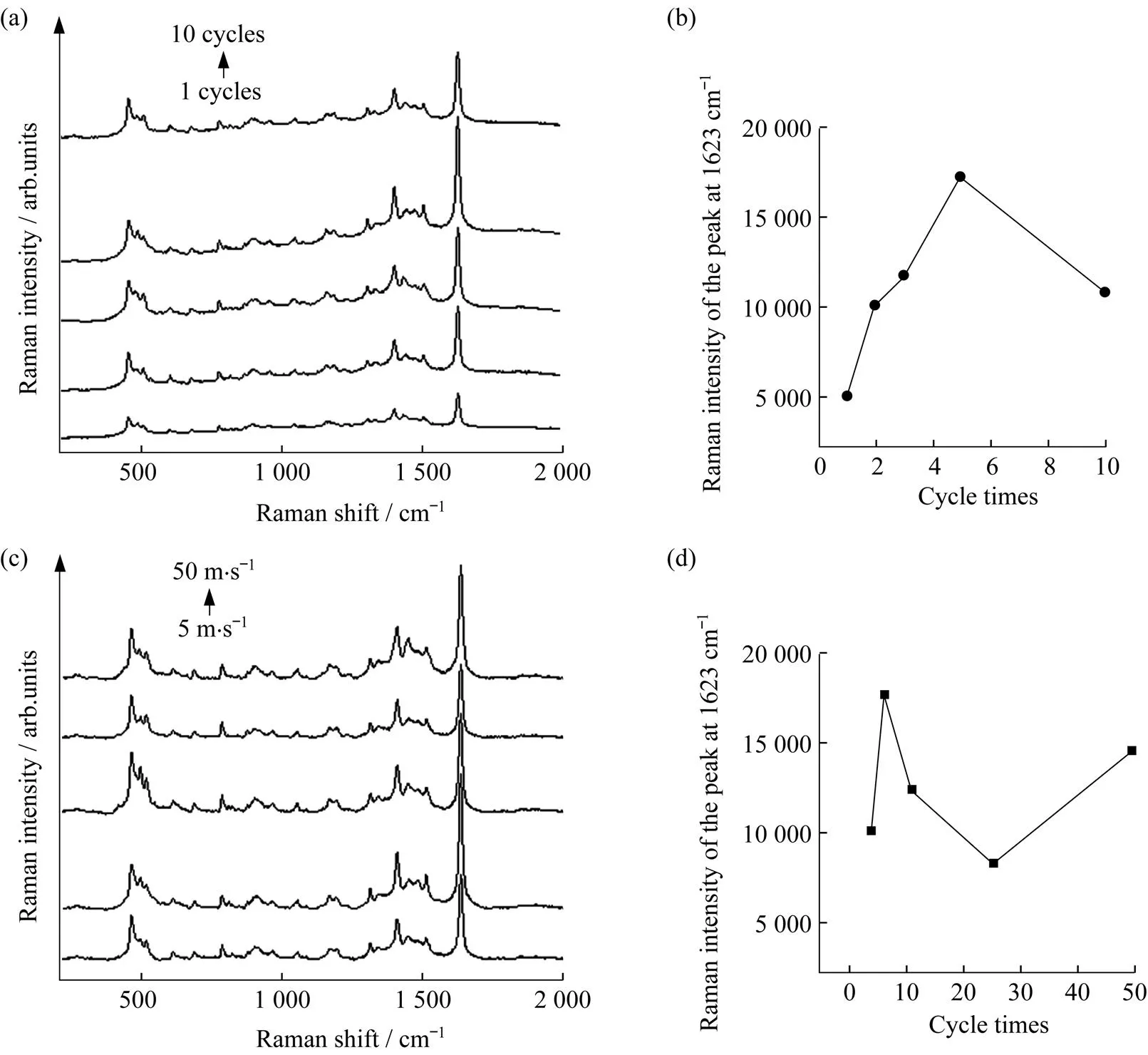From old digital video disk to SERS strips with controllable electrochemical method
ZHENG Qiangting, XUE Luyuan, LI Qinyi, WU Yiping, WEN Ying, GUO Xiaoyu, YANG Haifeng
From old digital video disk to SERS strips with controllable electrochemical method
ZHENG Qiangting†, XUE Luyuan†, LI Qinyi, WU Yiping, WEN Ying, GUO Xiaoyu*, YANG Haifeng*
(College of Chemistry and Materials Science, Shanghai Normal University, Shanghai 200234, China)
For surface-enhanced Raman scattering (SERS) spectroscopy as a highly sensitive detection technique, the preparation of substrates with highly active and low cost remains a challenge. In this work, cheap commercial digital video disk (DVDs) were adopted as supports forsynthesis of Ag-Au composite nanostructure as SERS substrates by using electrochemical technique. Ag-Au orbital cluster morphology was obtained on the surface of gold and silver reflectors layer with a series of grooves in DVD through the method of electrochemical roughen technique, without addition of the precursor solution of AgNO3and HAuCl4. After characterization and optimization, the SERS performances of the Ag-Au composite nanostructure were investigated. The results confirmed that this DVD-derived substrate exhibited excellent enhancement performance for different Raman probe molecules, high uniformity (relative standard deviation (RSD) is 7.88%), and better stability in the room temperature. Such a facile and effective preparation along with efficient SERS properties makes DVD-derived SERS substrates be very good candidates for the development of convenient and disposable sensing platforms.
surface-enhanced Raman scattering (SERS); electrochemical; digital video disk (DVD) substrate
1 Introduction
Firstly in 1974, FLEISCHMANN et al[1]reported that pyridine molecules absorbed on silver electrode surface treated by the electrochemical method exhibited the amplified Raman signal, which further was explored by Van Duyne[2]in 1977 and named as surface enhanced Raman scattering (SERS). Nowadays, SERS technique has been developed to single molecule level[3]and shows great application potential in the qualitative and quantitative analysis of trace species[4]as a fast, non-invasive, relatively accurate and non-interfered water detection assay.
On the acceptable views, the enhancement effect of SERS mainly comes from the electromagnetic enhancement (EM), as the molecules with inherent weak Raman cross section absorbed at or approaching to the surface of plasmonic metals[5-11]. So far, gold, silver, copper and some alkali metals excited by visible lasers have shown the obvious SERS effects. Generally speaking, the enhancement factor (EF) of plasmonic metals is dependent on their shape, structure and size of nanoparticles and routinely, EF of core-shell Ag-Au composite due to the symbiotically synergistic effects from bimetallic composite is higher than pure Ag and Au[12].
Noble metal nanoparticles, which are easy to be prepared and to produce surface plasmon resonance “hot spot”[13], have been extensively explored but their poor stability leads to poor signal repeatability, limiting their practical applications[14]. Two-dimensional (2D) SERS substrate which have improved optical stability and signal acquirement reproducibility was regarded as the crucial role for the development of SERS application strategies[15]. Additionally, for improving the reproducibility and SERS enhancement effect of 2D substrates, a variety of surface treatment technologies including metal nano lithography[16],electron beam lithography[17],plasma etching technique[18]have been used. However, the successful application of these technologies required professional knowledge, sophisticated operation steps, and costly equipment.
Compact disk (CD) and digital video disk (DVD) were once numerous and commercially available, but the old or broken disks have resulted in many environmental issues[19]. The disc consists of a protective layer, a dye layer and a reflective layer. Among them, polycarbonate is a non-degradable white pollutant, which causes secondary pollution to the environment through simple burial or incineration. The alloy material in the outer layer of discarded optical disk also brings heavy metal pollution in underground water, directly threatening human health. For the recycle purpose, in literature, DVDs with the unique wave-shaped template structure have been applied in preparation of electrochemical biosensors[20].
In this work, the old DVD was treated by electrochemical (EC) method to synthesize Ag-Au composite substrate for SERS application without the addition of AgNO3and HAuCl4. After EC treatment, gold and silver reflectors of DVD in groove structure formed orbital cluster morphology, which exhibited high SERS activity for target molecules and excellent uniformity with relative standard deviation (RSD) of about 7%. The high quality of SERS spectra recorded from several Raman probe molecules remarks good application universality of such substrate. In addition, the DVD-based substrate could be cut into many small strips as disposable SERS substrate, which is beneficial to real detection fields.
2 Experimental section
2.1 Materials
Potassium chloride (KCl), hydrochloric acid (HCl), methylene blue trihydrate (MB), methyl violet, rhodamine B, 4-thiadiazole (4-APTD), monopotassium phosphate (KH2PO4) and sodium hydrogen phosphate (Na2HPO4) were purchased from Sinopharm Chemical Reagent Co., Ltd. (Shanghai, China). Dopamine was obtained from Sigma-Aldrich (USA). Phosphate buffer solution (PBS pH=7.0, 0.1 mol·L-1) was prepared by KH2PO4and Na2HPO4. All chemicals and reagents are of analytical grade and used directly without further purification. In this experiment, all glassware was treated with aqua regia, rinsed with ultrapure water (18.2 MΩ·cm). The DVD (Verbatim) was bought from the market and had been used for data storage.
2.2 Preprocessing of DVD strip
The polymeric films of DVD were firstly peeled to exposure the gold and silver layer, and then peeled DVD was cut into strips with a size of 0.5 cm×5 cm. The strip as electrode was cleaned by ultrasonic in ethanol and ultrapure water for 5 min successively to remove the residual organic dye molecules on the surface, and finally dried with nitrogen for use.
2.3 Roughening DVD strip
The DVD strip was roughened on the electrochemical workstation (Shanghai Chenhua Instrument Co., Ltd.). In detail, the cleaned DVD strip, Pt wire, and the saturated calomel electrode were used as working, counter, and reference electrodes, respectively. Two different setups for oxidation reduction of DVD strips were performed, including cyclic voltammetry (CV) scanning in a 0.1 mol·L-1HCl solution by applying the potential range from -0.3 to 0.3 V at a sweep rate of 5 mV·s-1for 5 cycles, designated as DVD-CV and the multi-step potential step in a 0.1 mol·L-1PBS (pH=7.0) buffer solution with the process, which set the initial potential to -0.4 V and then stepped to 0.2 V. In addition, time of two potentials was held for 0.2 s, and the cycles were set at 2 000 times. The final product was designated as DVD-S.
2.4 SERS measurement
The electrochemically roughened DVD strips were immersed into the solution containing probe molecule for 20 min, and washed with pure water. After the strips with sample were blown dry with nitrogen, SERS measurements were carried out and the acquisition time set 8 s with 3 accumulations.
2.5 Apparatus
A field emission scanning electron microscope (FESEM:S-4800, Hitachi Co.,Ltd.) was used to observe the morphology of DVD strip. The Raman experiment was carried out on the confocal microscopy laser Raman system (JY, SuperLabRam Ⅱ) equipped with 633 nm He-Ne laser (5 mW), controlled with LabSpec5 software.
3 Results and discussion
3.1 FESEM observation
Typical FESEM morphology of unprocessed DVD strip is shown in figure 1(a). The track-like structure of gold and silver reflective layer of the DVD strip is seen and the track pitch and pit width are 0.74 μm and 0.4 μm, respectively. In figures 1(b)-1(c), by using cyclic voltammetry, the gold and silver reflective layer of DVD strip remains the orbital structure and appears the clusters in coral-like particles. In figure 1(d) for DVD-S, the wavy wrinkly structure composed of spherical nanoparticles with different sizes ranging between 20 nm and 70 nm can be observed through multi-step potential, showing poor uniform state. Obviously, the electrochemical deposition process dramatically affects the size and shape of final nanoparticles[21].

Figure 1FESEM images of Ag-Au layer of DVD with different roughening methods.
(a) untreated;(b,c) cyclic voltammetry;(d) multi-step potential
3.2 SERS performance
As mentioned above, SERS as a sensitive, rapid and molecular level method has been widely studied for the detection of chemicals and biological chemicals. Figure 2 is the SERS responses of methylene blue absorbed on the surface of DVD-CV and DVD-S. The SERS signal intensity of MB acquired on DVD-CV is higher than that by using DVD-S.
3.3 Effect of solution media on the treatment of DVD strips
In different solutions such as HCl (0.1 mol·L-1), KCl (0.1 mol·L-1) and PBS (0.1 mol·L-1, pH=7), DVD strips were roughened by cyclic voltammetry method. As shown in figures 3(a)-3(c), by using HCl as treatment solution, SERS signal from the DVD strip demonstrates the greatest intensity. The aggregation of AgNPs happened due to the addition of Cl-, which benefits the formation of plenty of hot spots. It is worth noting that the content of Cl-in DVD strip treated with HCl solution is higher than that with KCl, inducing the DVD strip by using HCl as treatment solution has good SERS activity.

Figure 2SERS spectra of methylene blue on the DVD strip prepared by different procedures
Figure 3SERS spectra of methylene blue on the DVD strip made in the different solutions
3.4 Optimization of CV conditions
Figure 4(a) is SERS spectra of MB recorded on the DVD strip obtained by using CV with constant scanning rate of 5 mV·s-1and different scanning cycles. According to the statistical plot on Raman peak at 1 623 cm-1in figure 4(b), with the scanning of 5 cycles, DVD-CV manifests the optimal SERS signal of MB. In the same way, fixing the scan cycles of 5, as given in figures 4(c) and figures 4(d), the highest SERS response of MB was obtained with a scan rate of 5 mV·s-1. Consequently, the 5 cycles and 5 mV·s-1of scan rate are the final option for CV treating the DVD strips in HCl solution.

Figure 4SERS spectra of methylene blue on the DVD strip prepared by different (a) CV cycles and (c) scan rates. Plots of the Raman peak at 1 623 cm-1by different (b) cycles and (d) scan rates
3.5 Uniformity and stability of DVD strip
The uniformity and stability of the DVD strips were also explored. As shown in figure 5(a), the SERS signals of MB recorded on randomly selected 10 points of one DVD strip surface and the clear visualization from histogram of the Raman intensities at 1 623 cm-1in figure 5(d) are uniform with a reasonable RSD of 7.88%. Furthermore, after the DVD strips were stored under ambient condition for two weeks (figure 5(b) and 5(e)), the peak intensity at 1 623 cm-1just attenuates by 6%, and the RSD is 6.20%, indicating the as-prepared substrates have good stability.

Figure 53-D SERS spectra of MB on the DVD strip.
(a) freshly prepared;(b) 14 d storage;(c) 28 d storage and the bar chart of the Raman intensity of the peak 1 623 cm-1;(d) freshly prepared;(e)14 d storage;(f) 28 d storage
3.6 SERS universality of DVD strip
To check the SERS application universality of DVD substrate, dye molecules, drug molecules, biological molecules such as rhodamine B, methyl violet, 4-APTD, and dopamine were picked out as Raman reporters. As shown in figure 6, SERS spectra of the above samples have good quality and all Raman peaks are consistent with the corresponding Raman bands reported in literature[22-23]. It indicates good universality of DVD strip as SERS substrate.

Figure 6SERS spectra recorded the optimal DVD strips for (a) Rhodamine B,(b) methyl violet,(c) 4-APTD,(d) dopamine. The concentration of all substances is 10-4mol·L-1
4 Conclusion
In summary, DVD strip with track Ag and Au alloy was easily prepared through roughening by using the optimized CV method without addition of precursors of Au and Ag. The strip presented high SERS activity, good universality, excellent uniformity and satisfactory stability. The DVD strips as a novel disposable SERS substrate could be used on-field detection purpose at trace level.
[1] FLEISCHMANN M, HENDRA P, MCQUILLA A. Raman spectra of pyridine adsorbed at a silver electrode [J]. Journal of Chemical Physics Letter, 1974,26(2):163-166.
[2] JEANMAIRE D L, VAN DUYNE R P. Surface Raman spectroelectrochemistry: Part I. heterocyclic, aromatic, and aliphatic amines adsorbed on the anodized silver electrode [J]. Journal of Electroanalytical Chemistry and Interfacial Electrochemistry, 1977,84(1):1-22.
[3] LIM D, JEON K, HYUNG M, et al. Nanogap-engineerable Raman-active nanodumbbells for single-molecule detection [J]. Nature Materials, 2010,9(1):60-67.
[4] GUO S J, DONG S J. Metal nanomaterial-based self-assembly: development, electrochemical sensing and sers applications [J]. Journal of Materials Chemistry, 2011,42(21):16704-16716.
[5] LUO S C, SIVASHANMUGAN K, LIAO J D, et al. Nanofabricated sers-active substrates for single-molecule to virus detection in vitro: a review [J]. Biosensors and Bioelectronics, 2014,61:232-240.
[6] SONG D, YANG R, LONG F, et al. Applications of magnetic nanoparticles in surface-enhanced Raman scattering (SERS) detection of environmental pollutants [J]. Journal of Environmental Sciences (China), 2019,80:14-34.
[7] ARAVIND P, ITZAN A, METIU H. The interaction between electromagnetic resonances and its role in spectroscopic studies of molecules adsorbed on colloidal particles or metal spheres [J]. Surface Science, 1981,110(1):189-204.
[8] KING F W, VAN DUYNE R P, SCHATZ G C. Theory of Raman scattering by molecules adsorbed on electrode surfaces [J]. Journal Chemical Physics, 1978,69(10):4472-4481.
[9] MOSKOVITS M. Surface roughness and the enhanced intensity of Raman scattering by molecules adsorbed on metals [J]. Journal Chemical Physics, 1978,69(9):4159-4161.
[10] FUCHS R. Theory of the optical properties of ionic crystal cubes [J]. Physical Review, 1975,150(2):1173-1174.
[11] CREIGHTON J, BLATCHFORD C, ALBRECHT M. Plasma resonance enhancement of Raman scattering by pyridine adsorbed on silver or gold sol particles of size comparable to the excitation wavelength [J]. Journal of Chemical Society,1979,75:790-798.
[12] FAN M K, LAI F J, CHOU H L, et al. Surface-enhanced Raman scattering (SERS) from Au∶Ag bimetallic nanoparticles: the effect of the molecular probe [J]. Chemical Science, 2012,4(1):509-515.
[13] LANGER J, JIMENEZ D, AIZPURUA J, et al. Present and future of surface-enhanced Raman scattering [J]. ACS Nano, 2020,14(1):28-117.
[14] WU J J, ZHANG L, HUANG F, et al. Surface enhanced Raman scattering substrate for the detection of explosives: construction strategy and dimensional effect [J]. Journal of Hazardous Materials, 2020,12(17):387-394.
[15] YAN S, AN R , ZOU Y J, et al. Fabrication of polymer colloidal/Au composite nanofilms for stable and reusable SERS-active substrates with highly-dense hotspots [J]. Sensors and Actuators B: Chemical, 2020,302:127107-127120.
[16] ZHANG X Y, ZHAO J, WHITNEY A V, et al. Ultrastable substrates for surface-enhanced Raman spectroscopy: Al2O3overlayers fabricated by atomic layer deposition yield improved anthrax biomarker detection [J]. Journal of American Chemical Society, 2006,128(31):10304-10309.
[17] FROMM D, SUNDARAMURTHY A, KINKHABWALA A, et al. Exploring the chemical enhancement for surface-enhanced Raman scattering with Au bowtie nanoantennas [J]. Journal of Chemical Physics, 2006,124(6):1-4.
[18] XIAO D Z, RUAN Q D, LIU L L, et al. Improvement of GaN plasma etching uniformity by optimizing the coil electrode with plasma simulation and experimental validation [J]. Surface Coatings Technology, 2020,400:126252.
[19] MANUEL A, MARÍA J, FILOMENA P, et al. Reuse of CD and DVD wastes as reinforcement in gypsum plaster plates [J]. Materials, 2020,13(4):1-13.
[20] NABADWEEP C, ANKITA S, ANEESH M, et al. Blu-ray DVD as SERS substrate for reliable detection of albumin, creatinine and urea in urine [J]. Sensors and Actuators B: Chemical, 2019,285(19):108-115.
[21] GIALLONGO G, PILOT R, DURANTE C, et al. Silver nanoparticle arrays on a DVD-derived template: an easy & cheap SERS substrate [J]. Plasmonics, 2011,6(4):725-733.
[22] PAN Y C, WEN Y, GUO X Y, et al. 2-Amino-5-(4-pyridinyl)-1,3,4-thiadiazole monolayers on copper surface: observation of the relationship between its corrosion inhibition and adsorption structure [J]. Corrosion Science, 2013,73:274-280.
[23] WANG P, XIA M, LIANG O, et al. Label-Free SERS selective detection of dopamine and serotonin using graphene-Au nanopyramid heterostructure [J]. Analytical Chemistry, 2015,87(20):10255-10261.
从废旧DVD光盘到电化学方法可控的SERS基底
郑强廷†, 薛路远†, 李沁怡, 吴一萍, 文 颖, 郭小玉*, 杨海峰*
(上海师范大学 化学与材料工程学院,上海 200234)
表面增强拉曼散射(SERS)光谱是一种高灵敏的检测技术,但制备高活性和低成本的SERS基底仍然是一大挑战.采用低成本的商业数字视频光盘(DVD)作为载体,用电化学技术原位合成金-银(Ag-Au)复合纳米结构作为SERS基底.通过电化学粗糙化技术,无需添加硝酸银(AgNO3)和四氯金酸(HAuCl4)前驱体溶液,就可以在DVD光盘上的沟槽状金银反射层表面上得到Ag-Au轨道团簇形态.经过一系列表征和优化,研究了Ag-Au复合纳米结构的SERS性能.结果表明:这种DVD衍生的SERS基底对不同的拉曼探针分子均表现出优异的增强性能、高均匀性(相对标准偏差(RSD)为7.88%)和出色的稳定性.这种简便高效的制备方法以及较高的SERS活性,使得DVD衍生的SERS基底成为开发便捷和一次性传感平台的较佳选择.
表面增强拉曼散射(SERS); 电化学; 数字视频光盘(DVD)基底
10.3969/J.ISSN.1000-5137.2022.04.005
date: 2021-03-15
GUO Xiaoyu(1986—),female,research assistant,research area:construction of Raman probe for environmental applications. E-mail: gxy2012@shnu.edu.cn;YANG Haifeng(1968—),male,professor,research area: design of Raman detection strategies for biochemical application. E-mail: hfyang@shnu.edu.cn
ZHENG Q T, XUE L Y, LI Q Y, et al. From old digital video disk to SERS strips with controllable electrochemical method [J]. Journal of Shanghai Normal University(Natural Sciences), 2022,51(4):420‒427.
O 614.24
A
The National Science Foundation of China (21475088)
ZHENG Qiangting carried out the preparation of materials, data acquisition and writing. XUE Luyuan completed the characterization of part materials, detection of real sample and corresponding writing. These authors contributed equally to this work.
1000-5137(2022)04-0420-08
郑强廷, 薛路远, 李沁怡, 等. 从废旧DVD光盘到电化学方法可控的SERS基底 [J]. 上海师范大学学报(自然科学版), 2022,51(4):420‒427.
(责任编辑:郁慧,顾浩然)

